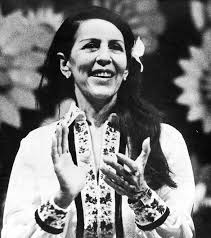
Celia Esther de los Desamparados Sánchez Manduley, known as Celia Sánchez Manduley, was a guerrilla fighter of the Cuban Revolution and one of Fidel Castro's closest collaborators from 1957 until her death. She was born in Media Luna, Oriente, on May 9, 1920. She was the daughter of Manuel Sánchez Silveira and Acacia Manduley Alsina.
On October 16 of that year she was registered in the Civil Registry of the Municipal Court of Vicana under the name of Celia Esther de los Desamparados, the same ones with which she would be baptized on July 22, 1922 in the parish of the Immaculate Conception from Manzanillo. Her third name was chosen because the girl was born the day after the religious festival of Our Lady of the Forsaken.
Celia received an education free of religious dogmatism and of any other kind of conventions and prejudices in which she had a lot to do with the personality of her father, a man with advanced liberal ideas.
She started elementary school at the age of 7 in a small private school where basically language and arithmetic were taught. She studied at this school until she moved to Manzanillo where she entered the public school of Pueblo Nuevo in fourth grade. Parallel to her primary education and together with her sister Flavia, she took piano lessons for about three years.
After the coup d'état of March 10, 1952, Celia became involved with several organizations with an insurrectionary profile. Manuel Echevarría, founder of the July 26 Movement, put her in contact with Frank País and Celia was integrated into the movement led by Fidel Castro.
In the July 26 Movement she never held leadership positions, although she did take on relevant tasks. With her nom de guerre, Norma, she became a fundamental figure in the days of the preparations for the Granma expedition and the beginning of the guerrilla struggle in the Sierra Maestra.
Following the Movement's guidelines, she organized a network of peasant collaborators in the vicinity where the expedition led by Fidel Castro was to disembark, which was essential for the continuity of the struggle.
In the most difficult moments of the guerrilla led by Fidel Castro, in February 1957 she marched to meet it in the company of Frank País, Faustino Pérez and other members of the National Directorate of the July 26 Movement to coordinate support from the plain, and guide New York Times journalist Herbert Matthews into Fidel's presence. The publication of the interview that the journalist did with the guerrilla leader would demolish the Batista propaganda based on the supposed death of Fidel. At the end of April, she would go up the Sierra again, guiding the North American journalist Bob Taber, who wanted to interview Fidel.
On May 28, as a member of the command squad, she fought in El Uvero. She was the first woman to hold the position of combat soldier in the ranks of the Rebel Army. A few days after that action, Fidel sent her back to the plains with important parcels. This was the stage of greatest danger for her, because to the persecution against her was added the betrayal of a Granma expeditionary, who betrayed many of the Movement's collaborators.
Until the middle of 1957 Celia had used, in addition to Norma, the pseudonyms of Lilian, Carmen and Caridad. On July 18 of that year, in a message from Frank to the Sierra, Celia's new nom de guerre appeared: Aly. However, Norma's pseudonym was so ingrained that she continued to be called like that in later letters. In a letter sent by the Sierra Maestra guerrillas to Frank País, they made clear the vital role of Celia during the war when they wrote:
With regard to the Sierra, when the history of this revolutionary stage is written, two names will have to appear on the cover: David and Norma.
Celia had a prominent role in the creation, on September 4, 1958, after a seven-hour meeting between Fidel and his General Staff, of the Mariana Grajales women's battalion, which operated in the area of La Plata, Sierra Maestra, in support of the guerrilla rear. This fact showed that Cuban women could also occupy positions as guerrilla fighters in the combats of the Rebel Army against the military forces of the Batista tyranny.
Celia assumed important tasks and responsibilities and was an active participant in the most transcendental moments of the Cuban Revolution, in all the relevant activities and the most significant works undertaken after the triumph of January 1, 1959. She was secretary of the Council of State, deputy to the Parliament, member of the Central Committee of the Communist Party of Cuba and of the National Directorate of the Federation of Cuban Women.
During the War of National Liberation, she devoted herself to compiling all the documentation of the struggle in the Sierra Maestra, making it possible to create the Office of Historical Affairs of the Council of State in 1964.
She, already very ill, participated in the Summit of Non-Aligned Countries in 1979. Also that year she traveled to the United Nations together with Fidel and the Cuban delegation. She is still seen in Santiago de Cuba on November 30, decorating veterans of that memorable armed uprising. Her illness could not defeat her even for a moment. She passes away 6 weeks later. She died on January 11, 1980.


